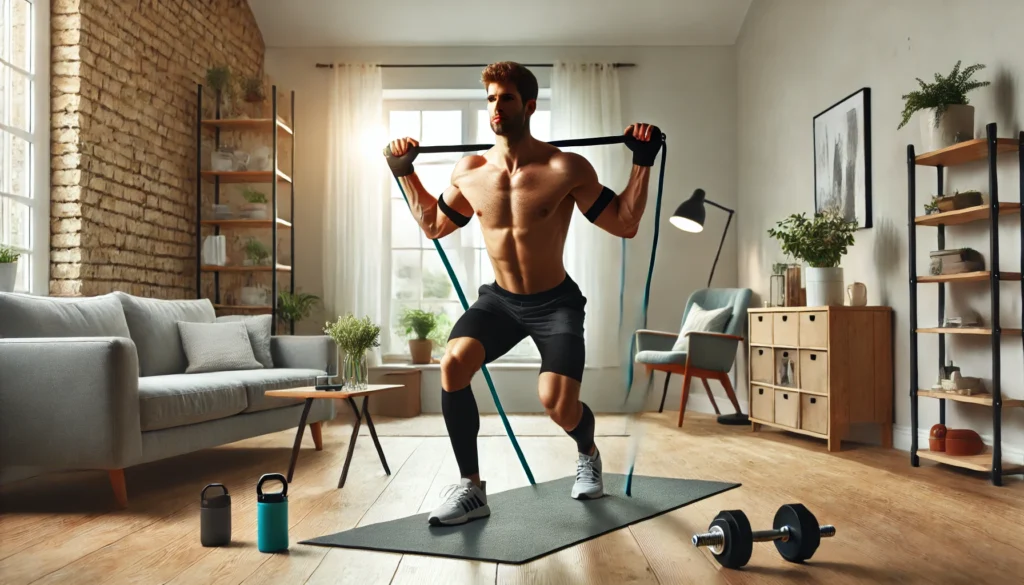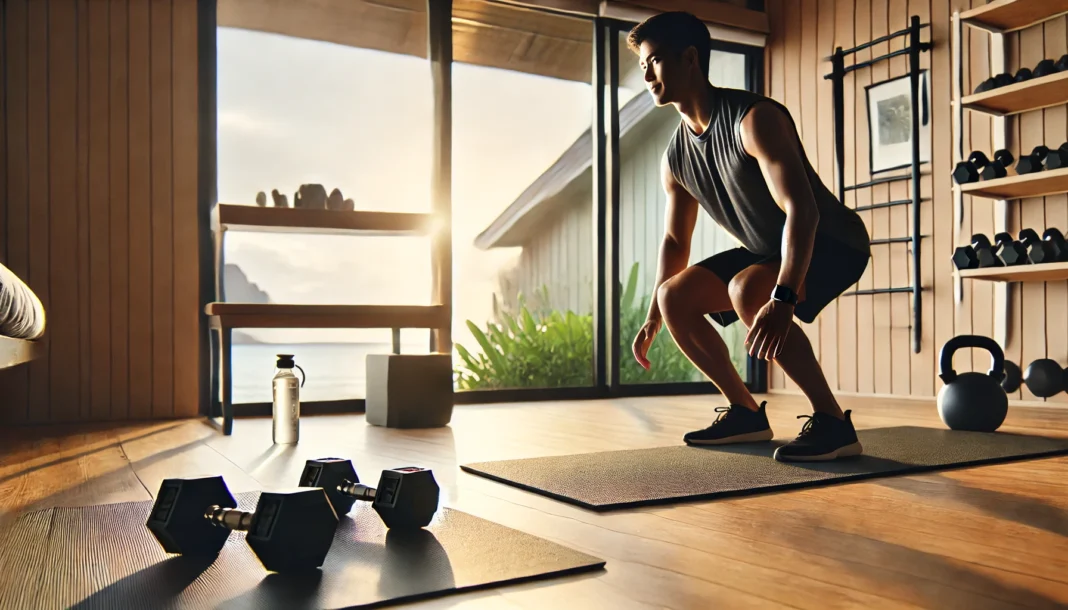Introduction: The Power of Strength Training at Home
Strength training at home has gained popularity as people seek effective ways to build muscle without relying on expensive gym memberships or equipment. While many assume that weightlifting is essential for hypertrophy, bodyweight training and resistance exercises at home without equipment can deliver comparable results. Understanding how to gain muscle at home requires knowledge of progressive overload, proper exercise selection, and consistent training. Additionally, an effective home strength workout incorporates techniques that maximize muscle activation, endurance, and recovery. Whether utilizing bodyweight exercises or minimal equipment, anyone can build substantial muscle mass at home with the right approach.
You may also like: The Ultimate Bodyweight Workout Routine for Full-Body Strength and Performance
The Science Behind Muscle Growth Without Weights
Muscle hypertrophy occurs when muscle fibers undergo stress and recover stronger than before. Traditionally, weightlifting at home or in the gym has been the primary method for inducing hypertrophy, but resistance training at home without equipment can achieve the same results through mechanical tension and metabolic stress. Engaging in workouts to gain muscle mass at home using calisthenics and isometric holds provides enough resistance to stimulate growth. Additionally, time-under-tension techniques, such as slow eccentric movements and pause reps, further enhance muscle engagement. Consistency, proper nutrition, and recovery are equally critical in maximizing gains from a home workout for muscle growth.
Essential Strength Training Workouts at Home
- Push-Ups: A foundational strength exercise that targets the chest, triceps, and shoulders, with variations such as diamond push-ups and archer push-ups increasing difficulty.
- Squats: An essential lower-body exercise that builds quadriceps, hamstrings, and glutes, while variations like pistol squats enhance balance and strength.
- Pull-Ups and Chin-Ups: Effective for back and bicep development, pull-up bars or resistance bands can be used to create progressive overload.
- Dips: Utilizing parallel bars or furniture, dips target the triceps and lower chest, contributing to upper-body strength.
- Planks and Core Exercises: Core stability is essential for full-body strength, with exercises such as leg raises, hanging knee tucks, and oblique twists improving muscular endurance.
Progressive Overload Without Weights
Progressive overload is key to muscle development, whether through weight lifting at home or bodyweight resistance. To increase difficulty in bodyweight exercises, individuals can modify leverage, increase repetitions, add explosive movements, or perform unilateral exercises. For example, transitioning from standard push-ups to one-arm push-ups significantly raises intensity. Similarly, incorporating explosive plyometrics, such as clap push-ups or jump squats, engages fast-twitch muscle fibers for enhanced strength. By strategically applying progressive overload, resistance exercises at home without equipment can continuously challenge muscles and promote growth.
How to Gain Muscle at Home Without Equipment
Understanding how to gain muscle at home without equipment requires focusing on three primary factors: intensity, volume, and recovery. Intensity refers to how challenging an exercise is, which can be adjusted through tempo, isometric holds, or movement modifications. Volume includes the total number of sets and repetitions performed within a session. Recovery ensures muscles have adequate time to repair and grow, with proper sleep, hydration, and nutrition playing critical roles. Combining these elements results in a comprehensive strategy for muscle building exercises at home.
Optimizing Nutrition for Home-Based Strength Training
Gaining muscle at home extends beyond exercise; nutrition is a fundamental component. Protein intake is essential for muscle recovery, with sources such as lean meats, eggs, dairy, and plant-based proteins supporting hypertrophy. Carbohydrates provide the necessary energy for strength exercises at home, fueling high-intensity training. Healthy fats contribute to hormone regulation, ensuring optimal muscle growth. Hydration and micronutrients, including vitamins and minerals, play supporting roles in muscle function and recovery. A well-balanced diet enhances the effectiveness of a home strength workout and promotes long-term muscle development.
The Role of Recovery in Home Strength Training Workouts
Recovery is an often-overlooked aspect of muscle development, whether following weight training at home or bodyweight resistance exercises. Adequate sleep is necessary for hormone regulation and muscle repair, with 7-9 hours recommended for optimal recovery. Active recovery techniques, including stretching, foam rolling, and mobility drills, enhance flexibility and reduce soreness. Managing stress and maintaining proper hydration further support muscle recovery. Incorporating rest days ensures continued progress and prevents overtraining, which can lead to fatigue and injury.

Advanced Strategies for Maximizing Home Workouts
For individuals seeking how to increase muscle mass at home without conventional gym equipment, several advanced strategies can enhance results. Resistance bands offer an effective way to add external resistance without heavy weights, providing a portable and affordable alternative to gym training. Unilateral training, such as single-leg squats or one-arm push-ups, increases core engagement and corrects muscular imbalances. Incorporating dynamic movements, such as burpees or mountain climbers, enhances cardiovascular fitness while maintaining muscle-building intensity. Additionally, combining isometric holds with explosive movements can lead to greater muscle activation and endurance.
Overcoming Common Challenges in Home Strength Training
One of the main challenges in performing workouts to gain muscle mass at home is maintaining motivation and consistency. Setting realistic goals, tracking progress, and following a structured program help ensure steady improvements. Another common obstacle is limited exercise variety, which can be addressed by regularly incorporating new movement patterns and intensity techniques. For those lacking space or equipment, bodyweight compound movements provide a versatile solution. Ensuring proper technique and form also prevents injuries and enhances the effectiveness of resistance training at home without equipment.

Frequently Asked Questions (FAQ) on Building Muscle at Home
1. Can I build as much muscle at home as I would in a gym?
Yes, you can build significant muscle mass with strength training at home, provided you apply the principles of progressive overload, intensity variation, and proper recovery. While weight training at home may not provide access to heavy gym equipment, bodyweight and resistance-based exercises can effectively stimulate hypertrophy. Incorporating resistance exercises at home without equipment, such as push-ups, dips, and squats, can enhance strength development when performed with increased volume and time under tension. Additionally, household items like backpacks filled with books can serve as makeshift weights to add resistance. Consistency, structured programming, and a balanced diet are key components to maximizing muscle gains outside the gym.
2. What are the most effective home exercises to gain muscle?
Several home exercises to gain muscle mimic the benefits of traditional weightlifting without the need for equipment. Push-ups and their variations effectively target the chest, shoulders, and triceps, while dips strengthen the upper body. Squats and lunges work the lower body, helping to build leg muscles without weights. Isometric exercises, such as planks and wall sits, enhance endurance and core stability. When combined into a structured home strength workout, these exercises maximize muscle growth and functional strength.
3. How do I increase resistance in my home workout for muscle growth?
To increase resistance without gym equipment, you can manipulate leverage, tempo, and exercise progression. Performing unilateral exercises, such as single-leg squats and one-arm push-ups, increases intensity by shifting more load onto fewer muscles. Slowing down eccentric movements and adding static holds amplify muscle engagement and create greater metabolic stress. Resistance training at home without equipment can also be supplemented with resistance bands or weighted backpacks to mimic the effects of traditional weightlifting. Additionally, increasing volume through higher repetitions and supersets ensures continued muscle stimulation and adaptation.
4. How important is nutrition in building muscle without a gym?
Nutrition plays a crucial role in how to gain muscle at home, as muscle growth is highly dependent on protein synthesis, caloric intake, and nutrient timing. A diet rich in high-quality protein sources, such as lean meats, eggs, dairy, and plant-based proteins, supports muscle repair and recovery. Healthy fats and complex carbohydrates provide sustained energy for strength training workouts at home. Proper hydration and micronutrient intake further enhance performance and prevent muscle fatigue. Meal planning that aligns with training intensity ensures optimal results for muscle building exercises at home.
5. What are the best strategies to make workouts to gain muscle mass at home more effective?
Maximizing the effectiveness of home strength workouts involves structured programming, progressive overload, and periodization. Implementing supersets, drop sets, and tempo training can increase muscular fatigue and enhance hypertrophy. Performing compound movements, such as push-ups, squats, and dips, engages multiple muscle groups simultaneously. Recovery strategies, including foam rolling, mobility drills, and active stretching, help maintain flexibility and prevent injuries. Tracking progress and gradually increasing difficulty levels ensures continuous gains in strength and muscle mass.
6. How often should I train to gain muscle without weights?
Training frequency depends on individual fitness levels and recovery capacity. Beginners should aim for three to four weekly sessions, focusing on full-body or upper/lower splits to allow sufficient recovery. Advanced individuals can train five to six days a week, incorporating muscle-specific workouts to maximize hypertrophy. Recovery periods between workouts are essential to prevent overtraining and facilitate muscle repair. A well-balanced home workout to increase muscle mass with no equipment should integrate rest days and active recovery techniques. Adjusting intensity and volume over time ensures long-term progress.
7. How can I prevent muscle loss while training at home?
Muscle loss occurs when the body does not receive adequate resistance stimulus or proper nutrition. Engaging in resistance exercises at home without equipment with progressive overload prevents muscle atrophy. A diet rich in protein and essential nutrients supports muscle maintenance and recovery. Reducing prolonged inactivity and incorporating bodyweight exercises into daily routines helps sustain muscle mass. Optimizing sleep quality and stress management further contribute to muscle preservation. Consistency and adaptability in training ensure continued muscle retention even without a gym environment.
8. Can resistance training at home without equipment improve strength as much as weightlifting?
Yes, resistance training at home without equipment can be highly effective in improving strength when executed correctly. Exercises such as push-ups, dips, squats, and pull-ups target multiple muscle groups and develop functional strength. By increasing intensity through plyometrics, unilateral movements, and extended time under tension, bodyweight exercises can replicate the effects of weight training at home. The key is to continually challenge muscles with variations that enhance neuromuscular adaptation. Additionally, incorporating movement patterns that engage stabilizer muscles can improve overall athletic performance and coordination.
9. What are the best ways to track progress when training at home?
Tracking progress in a home strength workout involves monitoring performance metrics such as repetitions, sets, and workout duration. Keeping a workout journal or using a fitness app helps document improvements in strength and endurance. Measuring body composition changes, such as muscle definition and body fat percentage, provides insights into overall progress. Strength tests, including maximum push-ups or squat holds, gauge improvements over time. Regularly reassessing goals and adjusting workout intensity ensures continued advancement in muscle development.
10. How can I stay motivated to build muscle at home long-term?
Maintaining motivation for strength training at home requires setting clear goals and establishing a routine. Varying exercises and incorporating new challenges prevents boredom and keeps workouts engaging. Partnering with a virtual workout community or accountability group fosters consistency and encouragement. Setting short-term milestones, such as increasing reps or mastering new exercise variations, provides a sense of accomplishment. Focusing on long-term health benefits, such as improved mobility and endurance, reinforces the value of home-based strength training.

Conclusion: Achieving Muscle Growth Without a Gym
Building muscle at home is entirely feasible with the right approach to strength training, progressive overload, and recovery. Whether focusing on bodyweight exercises or incorporating minimal equipment, home-based training can yield impressive results when executed consistently. Understanding how to build muscle at home without equipment involves strategic exercise selection, proper nutrition, and adequate recovery. By adapting training intensity and maintaining discipline, individuals can achieve significant muscle growth without stepping into a gym. With dedication and smart programming, home workouts remain a powerful tool for developing strength, endurance, and overall fitness.
muscle growth, home fitness, calisthenics training, progressive overload, functional strength, mobility drills, workout recovery, endurance training, high-intensity training, home workout program, hypertrophy exercises, bodyweight fitness, resistance bands, strength adaptation, unilateral training, explosive strength, injury prevention, core engagement, optimal nutrition, active recovery.
Further Reading:
Gym Rat No More: 18 At-Home Exercises to Build Muscle
10 exercises to build muscle without weights or any gym equipment
How to Get a Full-Body Strength Training Workout at Home
Important Note: The content provided by HealthXWire is for informational purposes only and should not be construed as medical advice, diagnosis, or treatment. While we strive for accuracy, the information presented on this site may not reflect the most current research or medical guidelines. Always seek the advice of your physician or other qualified health provider with any questions you may have regarding a medical condition. HealthXWire does not endorse, recommend, or guarantee the efficacy of any products, services, or treatments mentioned on this site. Users should not disregard professional medical advice or delay seeking it because of something they have read on HealthXWire. HealthXWire is not liable for any damages, loss, or injury arising from reliance on the information provided herein.



